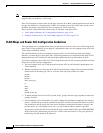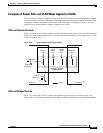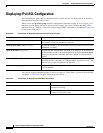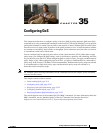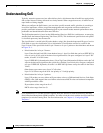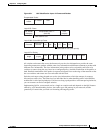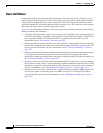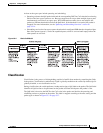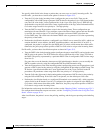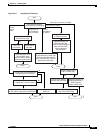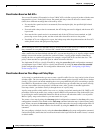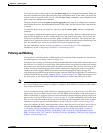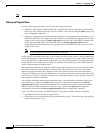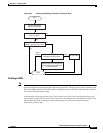
35-4
Catalyst 3750 Switch Software Configuration Guide
OL-8550-09
Chapter 35 Configuring QoS
Understanding QoS
Basic QoS Model
To implement QoS, the switch must distinguish packets or flow from one another (classify), assign a
label to indicate the given quality of service as the packets move through the switch, make the packets
comply with the configured resource usage limits (police and mark), and provide different treatment
(queue and schedule) in all situations where resource contention exists. The switch also needs to ensure
that traffic sent from it meets a specific traffic profile (shape).
Figure 35-2 shows the basic QoS model. Actions at the ingress port include classifying traffic, policing,
marking, queueing, and scheduling:
• Classifying a distinct path for a packet by associating it with a QoS label. The switch maps the CoS
or DSCP in the packet to a QoS label to distinguish one kind of traffic from another. The QoS label
that is generated identifies all future QoS actions to be performed on this packet. For more
information, see the “Classification” section on page 35-5.
• Policing determines whether a packet is in or out of profile by comparing the rate of the incoming
traffic to the configured policer. The policer limits the bandwidth consumed by a flow of traffic. The
result is passed to the marker. For more information, see the “Policing and Marking” section on
page 35-9.
• Marking evaluates the policer and configuration information for the action to be taken when a packet
is out of profile and determines what to do with the packet (pass through a packet without
modification, mark down the QoS label in the packet, or drop the packet). For more information, see
the “Policing and Marking” section on page 35-9.
• Queueing evaluates the QoS label and the corresponding DSCP or CoS value to select into which of
the two ingress queues to place a packet. Queueing is enhanced with the weighted tail-drop (WTD)
algorithm, a congestion-avoidance mechanism. If the threshold is exceeded, the packet is dropped.
For more information, see the “Queueing and Scheduling Overview” section on page 35-14.
• Scheduling services the queues based on their configured shaped round robin (SRR) weights. One
of the ingress queues is the priority queue, and SRR services it for its configured share before
servicing the other queue. For more information, see the “SRR Shaping and Sharing” section on
page 35-15.



